technical specifications Seat Alhambra 2013 Owner's Manual
[x] Cancel search | Manufacturer: SEAT, Model Year: 2013, Model line: Alhambra, Model: Seat Alhambra 2013Pages: 387, PDF Size: 6.13 MB
Page 339 of 387
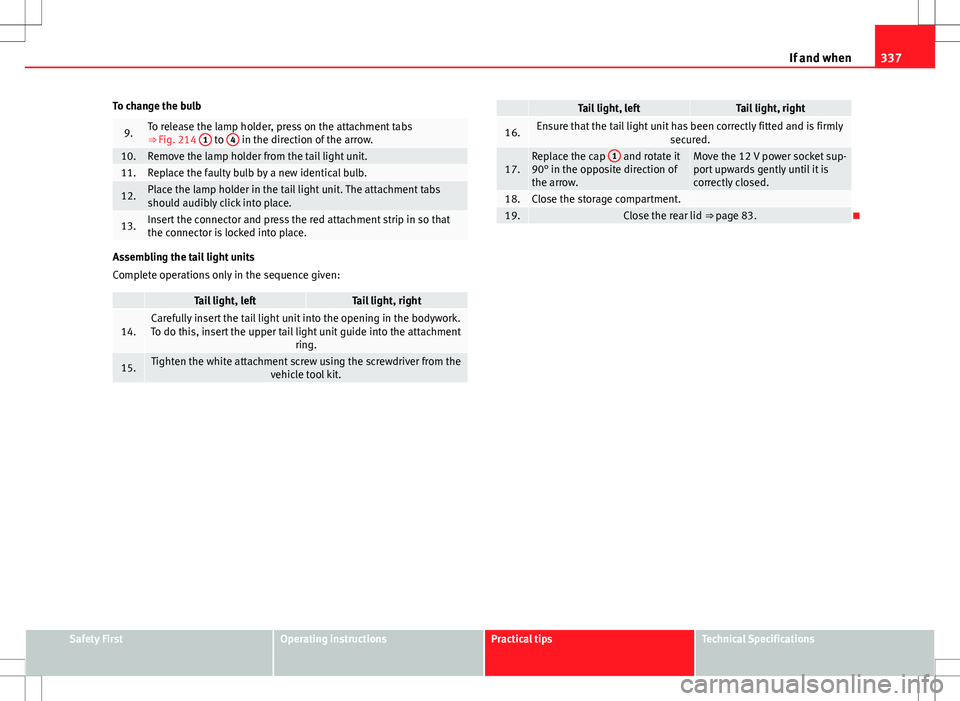
337
If and when
To change the bulb
9.To release the lamp holder, press on the attachment tabs
⇒ Fig. 214 1 to 4 in the direction of the arrow.10.Remove the lamp holder from the tail light unit.11.Replace the faulty bulb by a new identical bulb.
12.Place the lamp holder in the tail light unit. The attachment tabs
should audibly click into place.
13.Insert the connector and press the red attachment strip in so that
the connector is locked into place.
Assembling the tail light units
Complete operations only in the sequence given:
Tail light, leftTail light, right
14.Carefully insert the tail light unit into the opening in the bodywork.
To do this, insert the upper tail light unit guide into the attachment ring.
15.Tighten the white attachment screw using the screwdriver from thevehicle tool kit.
Tail light, leftTail light, right
16.Ensure that the tail light unit has been correctly fitted and is firmly secured.
17.Replace the cap 1 and rotate it
90° in the opposite direction of
the arrow.Move the 12 V power socket sup-
port upwards gently until it is
correctly closed.
18.Close the storage compartment. 19.Close the rear lid ⇒ page 83.
Safety FirstOperating instructionsPractical tipsTechnical Specifications
Page 341 of 387
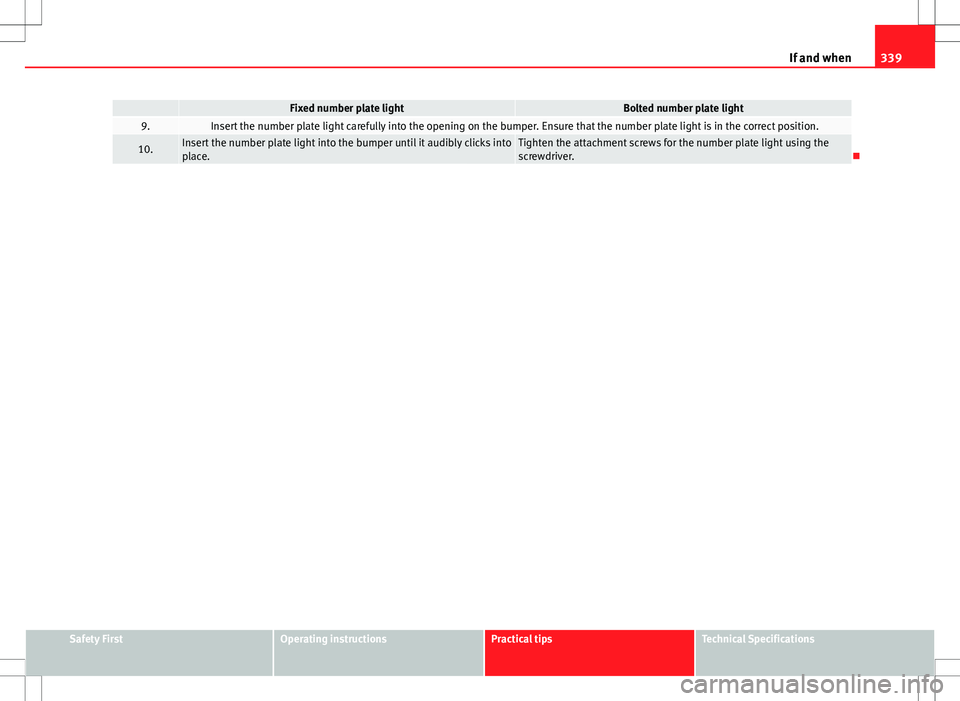
339
If and when
Fixed number plate lightBolted number plate light9.Insert the number plate light carefully into the opening on the bumper. Ensure that the number plate light is in the correct position.
10.Insert the number plate light into the bumper until it audibly clicks into
place.Tighten the attachment screws for the number plate light using the
screwdriver.
Safety FirstOperating instructionsPractical tipsTechnical Specifications
Page 343 of 387
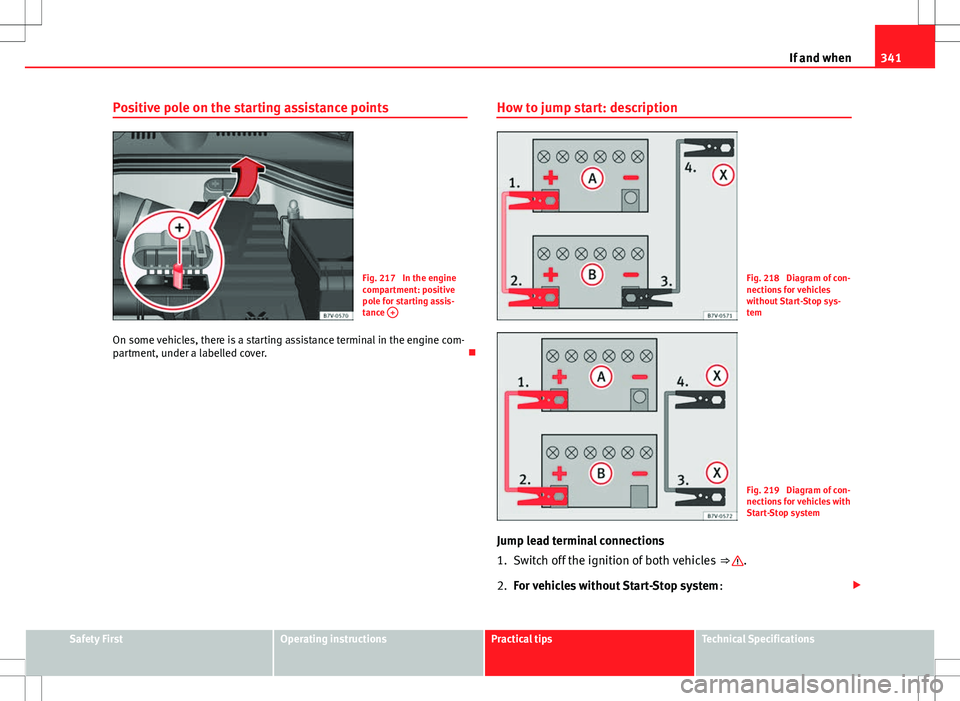
341
If and when
Positive pole on the starting assistance points
Fig. 217 In the engine
compartment: positive
pole for starting assis-
tance +
On some vehicles, there is a starting assistance terminal in the engine com-
partment, under a labelled cover. How to jump start: description
Fig. 218 Diagram of con-
nections for vehicles
without Start-Stop sys-
tem
Fig. 219 Diagram of con-
nections for vehicles with
Start-Stop system
Jump lead terminal connections
1. Switch off the ignition of both vehicles ⇒
.
2. For vehicles without Start-Stop system :
Safety FirstOperating instructionsPractical tipsTechnical Specifications
Page 345 of 387
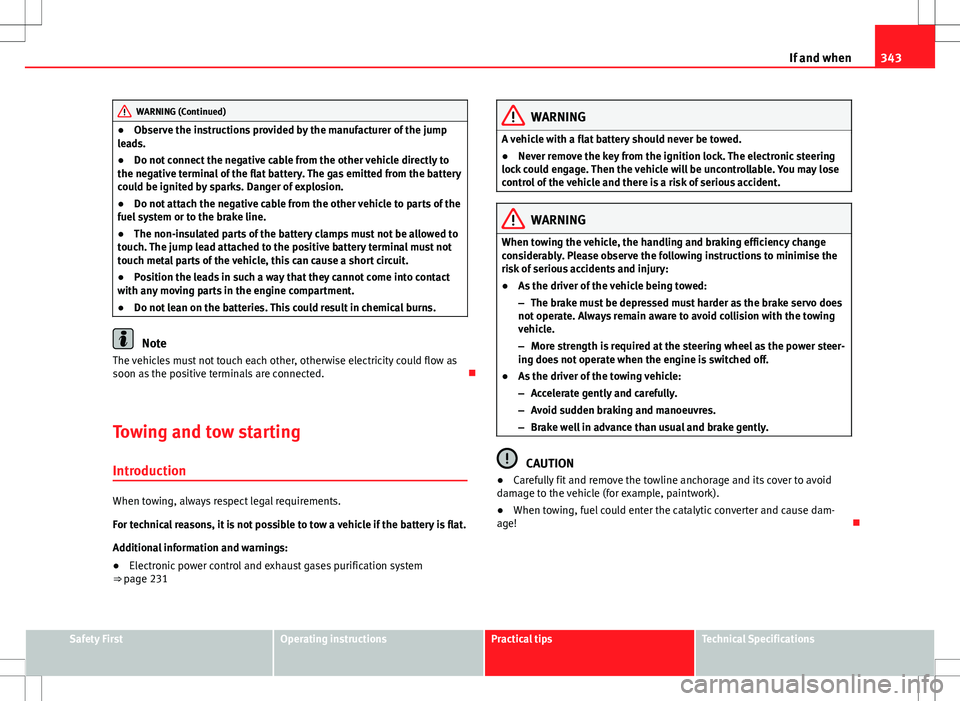
343
If and when
WARNING (Continued)
● Observe the instructions provided by the manufacturer of the jump
leads.
● Do not connect the negative cable from the other vehicle directly to
the negative terminal of the flat battery. The gas emitted from the battery
could be ignited by sparks. Danger of explosion.
● Do not attach the negative cable from the other vehicle to parts of the
fuel system or to the brake line.
● The non-insulated parts of the battery clamps must not be allowed to
touch. The jump lead attached to the positive battery terminal must not
touch metal parts of the vehicle, this can cause a short circuit.
● Position the leads in such a way that they cannot come into contact
with any moving parts in the engine compartment.
● Do not lean on the batteries. This could result in chemical burns.
Note
The vehicles must not touch each other, otherwise electricity could flow as
soon as the positive terminals are connected.
Towing and tow starting Introduction
When towing, always respect legal requirements.
For technical reasons, it is not possible to tow a vehicle if the battery is flat.
Additional information and warnings:
● Electronic power control and exhaust gases purification system
⇒ page 231
WARNING
A vehicle with a flat battery should never be towed.
● Never remove the key from the ignition lock. The electronic steering
lock could engage. Then the vehicle will be uncontrollable. You may lose
control of the vehicle and there is a risk of serious accident.
WARNING
When towing the vehicle, the handling and braking efficiency change
considerably. Please observe the following instructions to minimise the
risk of serious accidents and injury:
● As the driver of the vehicle being towed:
– The brake must be depressed must harder as the brake servo does
not operate. Always remain aware to avoid collision with the towing
vehicle.
– More strength is required at the steering wheel as the power steer-
ing does not operate when the engine is switched off.
● As the driver of the towing vehicle:
– Accelerate gently and carefully.
– Avoid sudden braking and manoeuvres.
– Brake well in advance than usual and brake gently.
CAUTION
● Carefully fit and remove the towline anchorage and its cover to avoid
damage to the vehicle (for example, paintwork).
● When towing, fuel could enter the catalytic converter and cause dam-
age!
Safety FirstOperating instructionsPractical tipsTechnical Specifications
Page 347 of 387
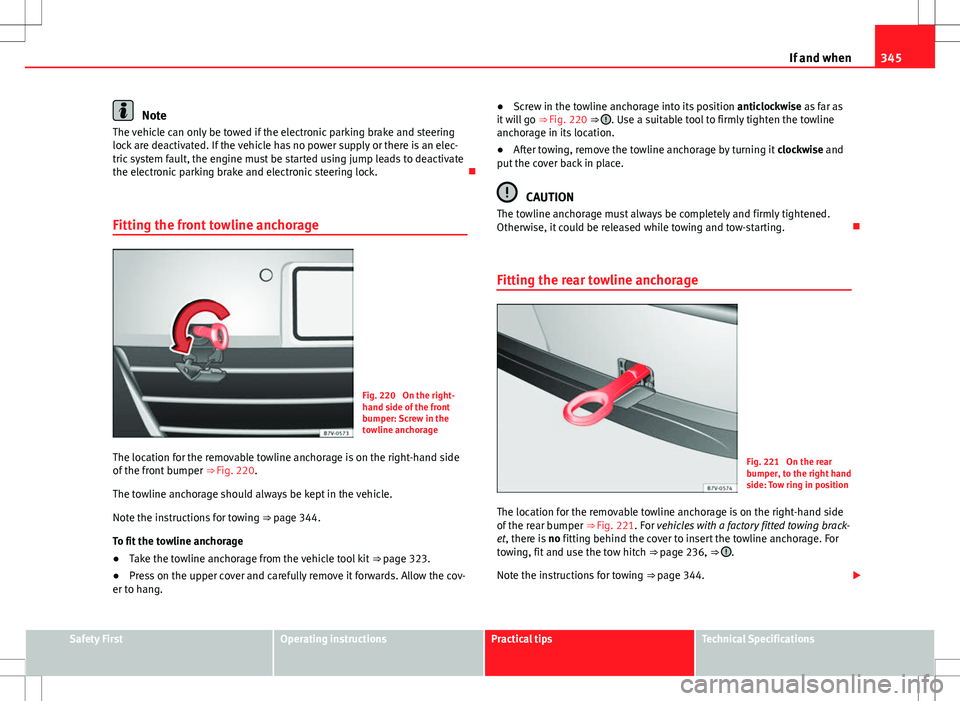
345
If and when
Note
The vehicle can only be towed if the electronic parking brake and steering
lock are deactivated. If the vehicle has no power supply or there is an elec-
tric system fault, the engine must be started using jump leads to deactivate
the electronic parking brake and electronic steering lock.
Fitting the front towline anchorage
Fig. 220 On the right-
hand side of the front
bumper: Screw in the
towline anchorage
The location for the removable towline anchorage is on the right-hand side
of the front bumper ⇒ Fig. 220.
The towline anchorage should always be kept in the vehicle.
Note the instructions for towing ⇒ page 344.
To fit the towline anchorage
● Take the towline anchorage from the vehicle tool kit
⇒ page 323.
● Press on the upper cover and carefully remove it forwards. Allow the cov-
er to hang. ●
Screw in the towline anchorage into its position anticlockwise as far as
it will go ⇒ Fig. 220 ⇒
. Use a suitable tool to firmly tighten the towline
anchorage in its location.
● After towing, remove the towline anchorage by turning it clockwise and
put the cover back in place.
CAUTION
The towline anchorage must always be completely and firmly tightened.
Otherwise, it could be released while towing and tow-starting.
Fitting the rear towline anchorage
Fig. 221 On the rear
bumper, to the right hand
side: Tow ring in position
The location for the removable towline anchorage is on the right-hand side
of the rear bumper ⇒ Fig. 221. For vehicles with a factory fitted towing brack-
et, there is no fitting behind the cover to insert the towline anchorage. For
towing, fit and use the tow hitch ⇒ page 236, ⇒
.
Note the instructions for towing ⇒ page 344.
Safety FirstOperating instructionsPractical tipsTechnical Specifications
Page 349 of 387
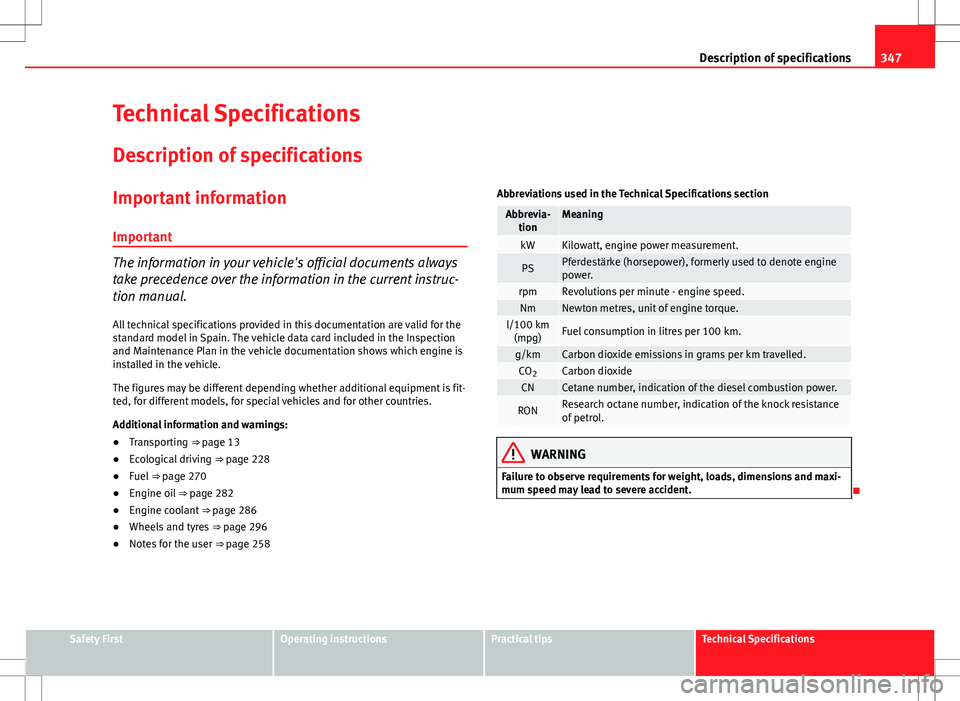
347
Description of specifications
Technical Specifications
Description of specifications Important information
Important
The information in your vehicle's official documents always
take precedence over the information in the current instruc-
tion manual. All technical specifications provided in this documentation are valid for the
standard model in Spain. The vehicle data card included in the Inspection
and Maintenance Plan in the vehicle documentation shows which engine is
installed in the vehicle.
The figures may be different depending whether additional equipment is fit-
ted, for different models, for special vehicles and for other countries.
Additional information and warnings:
● Transporting ⇒ page 13
● Ecological driving ⇒ page 228
● Fuel ⇒ page 270
● Engine oil ⇒ page 282
● Engine coolant ⇒ page 286
● Wheels and tyres ⇒ page 296
● Notes for the user ⇒ page 258 Abbreviations used in the Technical Specifications section
Abbrevia-
tionMeaning
kWKilowatt, engine power measurement.
PSPferdestärke (horsepower), formerly used to denote engine
power.
rpmRevolutions per minute - engine speed.NmNewton metres, unit of engine torque.l/100 km(mpg)Fuel consumption in litres per 100 km.
g/kmCarbon dioxide emissions in grams per km travelled.CO 2Carbon dioxideCNCetane number, indication of the diesel combustion power.
RONResearch octane number, indication of the knock resistance
of petrol.
WARNING
Failure to observe requirements for weight, loads, dimensions and maxi-
mum speed may lead to severe accident.
Safety FirstOperating instructionsPractical tipsTechnical Specifications
Page 351 of 387
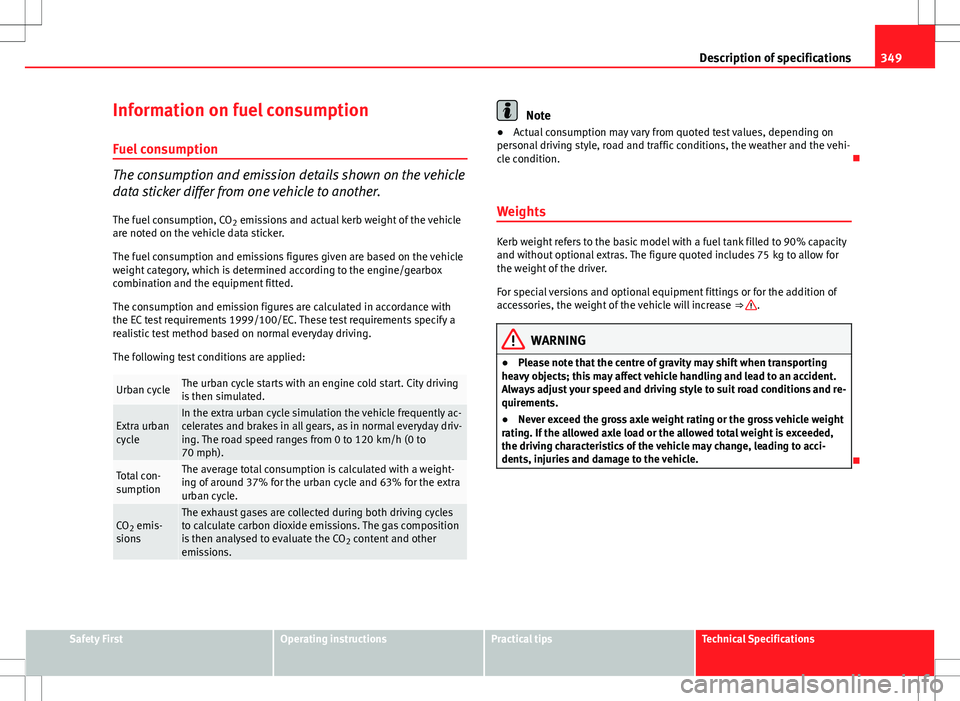
349
Description of specifications
Information on fuel consumption
Fuel consumption
The consumption and emission details shown on the vehicle
data sticker differ from one vehicle to another. The fuel consumption, CO 2 emissions and actual kerb weight of the vehicle
are noted on the vehicle data sticker.
The fuel consumption and emissions figures given are based on the vehicle
weight category, which is determined according to the engine/gearbox
combination and the equipment fitted.
The consumption and emission figures are calculated in accordance with
the EC test requirements 1999/100/EC. These test requirements specify a
realistic test method based on normal everyday driving.
The following test conditions are applied:
Urban cycleThe urban cycle starts with an engine cold start. City driving
is then simulated.
Extra urban
cycleIn the extra urban cycle simulation the vehicle frequently ac-
celerates and brakes in all gears, as in normal everyday driv-
ing. The road speed ranges from 0 to 120 km/h (0 to
70 mph).
Total con-
sumptionThe average total consumption is calculated with a weight-
ing of around 37% for the urban cycle and 63% for the extra
urban cycle.
CO 2 emis-
sionsThe exhaust gases are collected during both driving cycles
to calculate carbon dioxide emissions. The gas composition
is then analysed to evaluate the CO 2 content and other
emissions.
Note
● Actual consumption may vary from quoted test values, depending on
personal driving style, road and traffic conditions, the weather and the vehi-
cle condition.
Weights
Kerb weight refers to the basic model with a fuel tank filled to 90% capacity
and without optional extras. The figure quoted includes 75 kg to allow for
the weight of the driver.
For special versions and optional equipment fittings or for the addition of
accessories, the weight of the vehicle will increase ⇒
.
WARNING
● Please note that the centre of gravity may shift when transporting
heavy objects; this may affect vehicle handling and lead to an accident.
Always adjust your speed and driving style to suit road conditions and re-
quirements.
● Never exceed the gross axle weight rating or the gross vehicle weight
rating. If the allowed axle load or the allowed total weight is exceeded,
the driving characteristics of the vehicle may change, leading to acci-
dents, injuries and damage to the vehicle.
Safety FirstOperating instructionsPractical tipsTechnical Specifications
Page 352 of 387
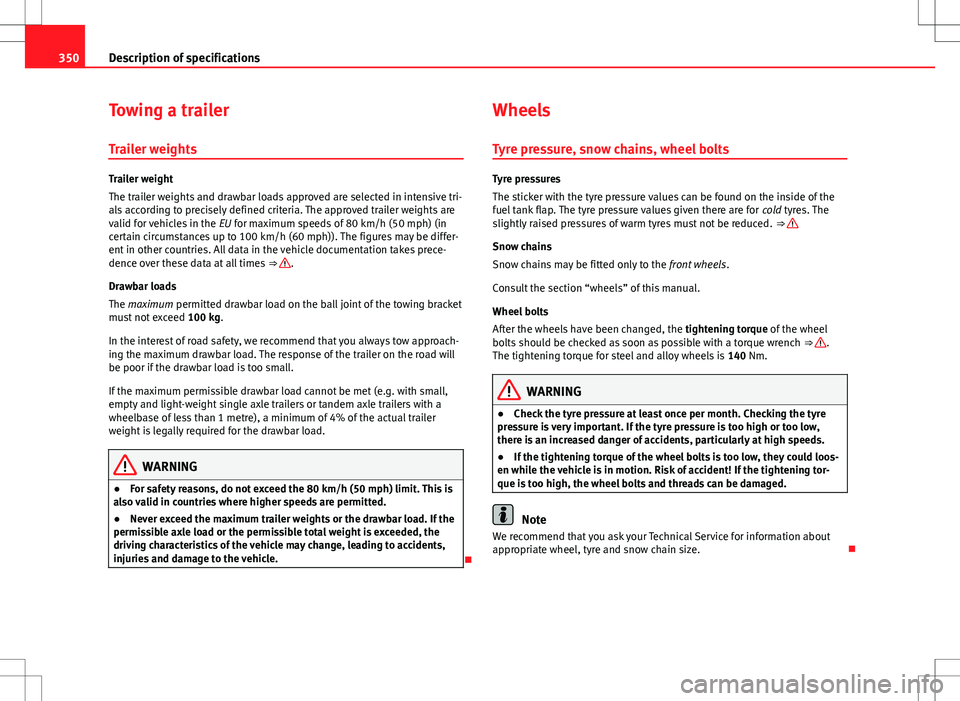
350Description of specifications
Towing a trailer
Trailer weights
Trailer weight
The trailer weights and drawbar loads approved are selected in intensive tri-
als according to precisely defined criteria. The approved trailer weights are
valid for vehicles in the EU for maximum speeds of 80 km/h (50 mph) (in
certain circumstances up to 100 km/h (60 mph)). The figures may be differ-
ent in other countries. All data in the vehicle documentation takes prece-
dence over these data at all times ⇒
.
Drawbar loads
The maximum permitted drawbar load on the ball joint of the towing bracket
must not exceed 100 kg.
In the interest of road safety, we recommend that you always tow approach-
ing the maximum drawbar load. The response of the trailer on the road will
be poor if the drawbar load is too small.
If the maximum permissible drawbar load cannot be met (e.g. with small,
empty and light-weight single axle trailers or tandem axle trailers with a
wheelbase of less than 1 metre), a minimum of 4% of the actual trailer
weight is legally required for the drawbar load.
WARNING
● For safety reasons, do not exceed the 80 km/h (50 mph) limit. This is
also valid in countries where higher speeds are permitted.
● Never exceed the maximum trailer weights or the drawbar load. If the
permissible axle load or the permissible total weight is exceeded, the
driving characteristics of the vehicle may change, leading to accidents,
injuries and damage to the vehicle.
Wheels
Tyre pressure, snow chains, wheel bolts
Tyre pressures
The sticker with the tyre pressure values can be found on the inside of the
fuel tank flap. The tyre pressure values given there are for cold tyres. The
slightly raised pressures of warm tyres must not be reduced. ⇒
Snow chains
Snow chains may be fitted only to the front wheels.
Consult the section “wheels” of this manual.
Wheel bolts
After the wheels have been changed, the tightening torque of the wheel
bolts should be checked as soon as possible with a torque wrench ⇒
.
The tightening torque for steel and alloy wheels is 140 Nm.
WARNING
● Check the tyre pressure at least once per month. Checking the tyre
pressure is very important. If the tyre pressure is too high or too low,
there is an increased danger of accidents, particularly at high speeds.
● If the tightening torque of the wheel bolts is too low, they could loos-
en while the vehicle is in motion. Risk of accident! If the tightening tor-
que is too high, the wheel bolts and threads can be damaged.
Note
We recommend that you ask your Technical Service for information about
appropriate wheel, tyre and snow chain size.
Page 353 of 387
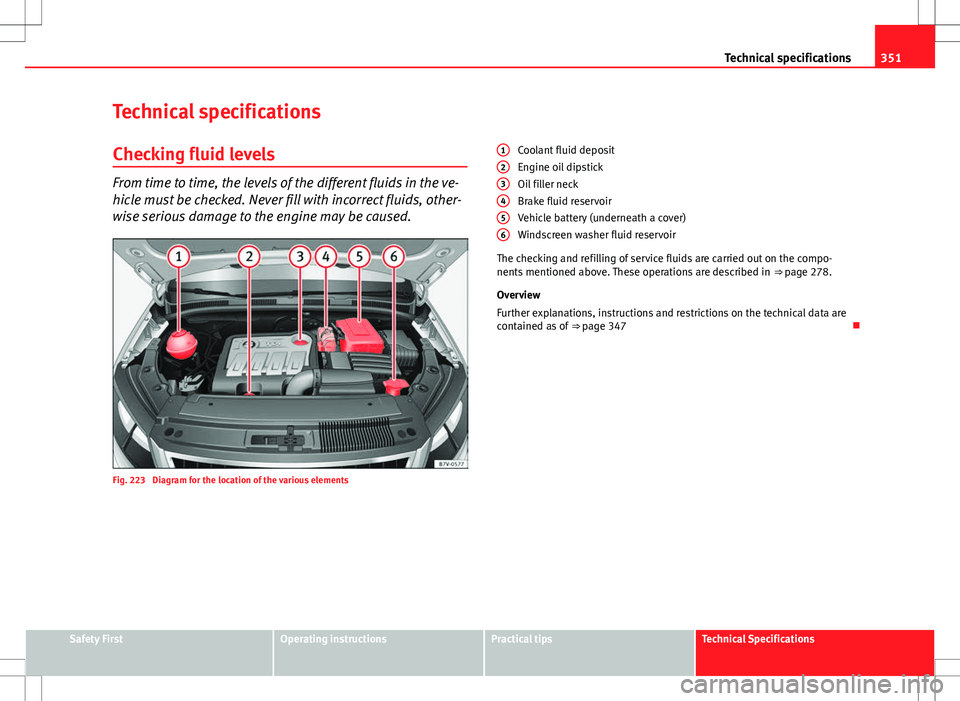
351
Technical specifications
Technical specifications
Checking fluid levels
From time to time, the levels of the different fluids in the ve-
hicle must be checked. Never fill with incorrect fluids, other-
wise serious damage to the engine may be caused.
Fig. 223 Diagram for the location of the various elements Coolant fluid deposit
Engine oil dipstick
Oil filler neck
Brake fluid reservoir
Vehicle battery (underneath a cover)
Windscreen washer fluid reservoir
The checking and refilling of service fluids are carried out on the compo-
nents mentioned above. These operations are described in ⇒ page 278.
Overview
Further explanations, instructions and restrictions on the technical data are
contained as of ⇒ page 347
1
23456
Safety FirstOperating instructionsPractical tipsTechnical Specifications
Page 354 of 387
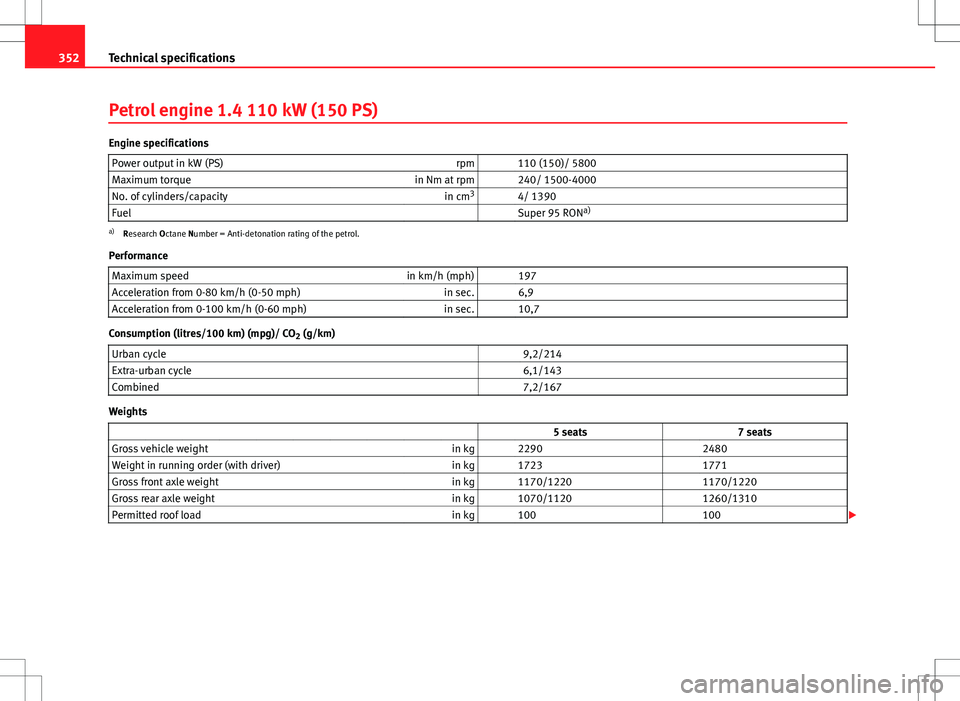
352Technical specifications
Petrol engine 1.4 110 kW (150 PS)
Engine specifications
Power output in kW (PS) rpm 110 (150)/ 5800
Maximum torque in Nm at rpm 240/ 1500-4000
No. of cylinders/capacity in cm3
4/ 1390
Fuel Super 95 RON a)
a)
Research Octane Number = Anti-detonation rating of the petrol.
Performance Maximum speed in km/h (mph) 197
Acceleration from 0-80 km/h (0-50 mph) in sec. 6,9
Acceleration from 0-100 km/h (0-60 mph) in sec. 10,7
Consumption (litres/100 km) (mpg)/ CO
2 (g/km)
Urban cycle 9,2/214
Extra-urban cycle 6,1/143
Combined 7,2/167
Weights
5 seats 7 seats
Gross vehicle weight in kg 2290 2480
Weight in running order (with driver) in kg 1723 1771
Gross front axle weight in kg 1170/1220 1170/1220
Gross rear axle weight in kg 1070/1120 1260/1310
Permitted roof load in kg 100 100